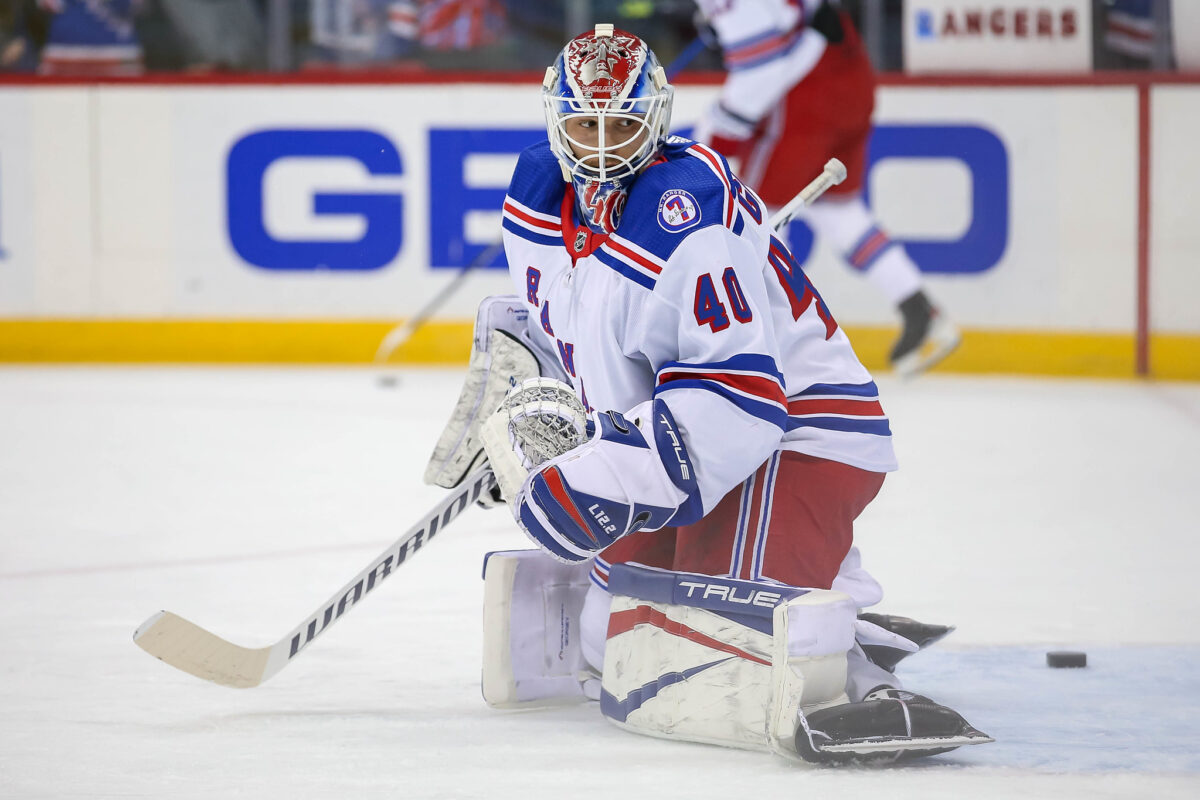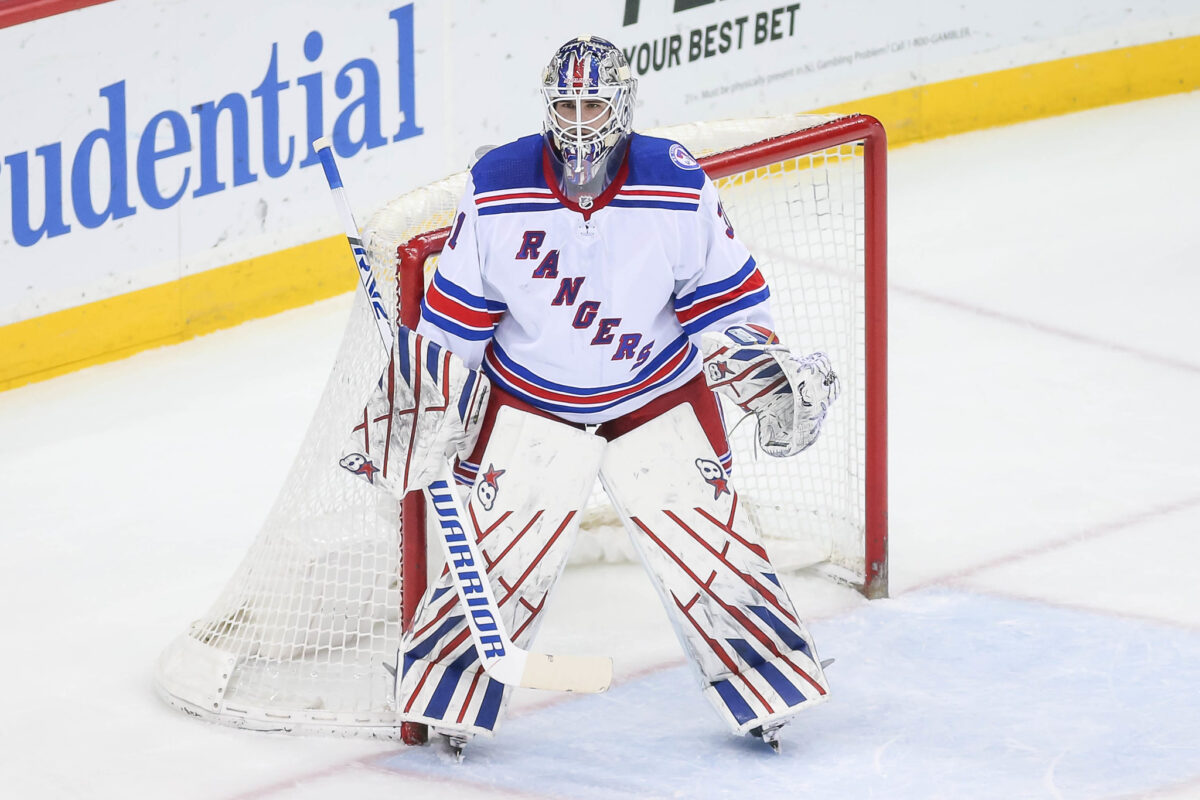After a brief period of uncertainty, the Colorado Avalanche have found their second goalie for the 2022-23 NHL season. In completing a trade with the New York Rangers for Russian goaltender Alexandar Georgiev, the 2022 Stanley Cup champions confirmed the eventual exit of pending unrestricted free agent (UFA) Darcy Kuemper, allowing him to hit the open market.

Although the organization has not yet signed the 26-year-old Georgiev to a contract at the time of this writing, it appears as though a deal is all but a formality. As a result, he will assume the Avalanche’s starting job after being blocked by Vezina Trophy winner Igor Shesterkin in the Rangers’ crease. His career has stalled since his first few seasons, but there is enough promise that he makes a good buy-low bet for general manager Joe Sakic to work his magic once more. Let’s dig into how Georgiev fits within Colorado’s goalie situation, examine his uneven career arc, and why he doesn’t need to be elite for the Avalanche to win.
Georgiev Has Inside Track for Avalanche Starting Job
Along with the newly-acquired Georgiev, the Avalanche will have 32-year-old Pavel Francouz on the books through the 2023-24 season while carrying a manageable $2 million hit against the cap. The journeyman netminder has functioned as a reliable backup option behind both Philipp Grubauer and Kuemper in recent seasons, most notably in the 2022 Stanley Cup Playoffs when the latter was sidelined with injury.
Since his first full NHL season in 2019-20, Francouz owns career rates of a .920 save percentage (SV%) that is tied for third among goalies with at least 41 games played and plus-3.81 goals saved above expected (GSAx), 20th in that time. Francouz’s career playoff numbers are underwhelming (.899 SV% and plus-0.27 GSAx), but he pitched a 24-save shutout in Game 2 of the 2022 Western Conference Final against the Edmonton Oilers, stymying the Oilers’ superstars.
Related: Avalanche’s Top Priorities for the 2022 Offseason
Francouz has put in strong regular-season performances for the Avalanche since signing as a free agent out of Europe, acting as a dependable stopgap when the primary option has faltered (from ‘Pavel Francouz’s path to the Avalanche starter’s net: Undrafted but dependable, ‘he always had to find his own way’’ – Peter Baugh, The Athletic, 06/04/22). Still, given the age difference between the two and the cost to acquire Georgiev, the younger goaltender is the favourite to be the Avalanche’s starter on the opening night of the season.
Georgiev’s NHL Career Is a Tale of Two Goalies
In taking a backseat to future Hall-of-Fame member Henrik Lundqvist and then becoming Shesterkin’s backup, Georgiev has never had a clear path to an NHL starting job. The latter’s emergence as a perennial Vezina Trophy nominee effectively slammed the door on Georgiev’s future with the Rangers, and that reality is borne out in his numbers. It’s possible that the uncertainty combined with inconsistent playing time stunted his development after a promising start, as evidenced by his career splits, separated by two distinct intervals during his Rangers’ tenure.
| Stat | 2017-2020 | 2020-2022 |
|---|---|---|
| Games Played | 77 (48) | 52 (42) |
| SV% | .913 (28) | .901 (42) |
| HDSV% | .837 (8) | .798 (47) |
| dFSV% | 0.39 (10) | -0.46 (36) |
| GSAx | 13.28 (12) | -8.65 (34) |
For reference, Delta Fenwick Save Percentage (dFSV%) is the difference between a goalie’s actually SV% on all unblocked shots and his expected total based on historical scoring rates from where shots are taken. The exact difference isn’t important, but rather whether the goalie is performing above- or below-average. GSAx is a similar tool but adjusts for a goalie’s workload, grading it based on the quality of chances faced.
Regardless, the difference between Georgiev’s numbers over the two timeframes is stark. By both traditional and advanced metrics, his results have tumbled to the territory of a fringe starter or an outright backup. As I mentioned before, the uncertainty surrounding his future (he was the topic of many trade rumours) and the inability to build up any rhythm through consistent playing time could be a culprit in his abrupt descent.

If a more certain future and faith in his abilities can lift Georgiev to his previous level, parting with only a few mid-round draft picks is a small price to pay for the remainder of his prime years.
Avalanche’s Stanley Cup Win Proves Elite Goaltending Not Required for Success
The Avalanche’s acquisition of Georgiev continues a recent trend of the organization parting ways with aging goaltenders about to secure a massive payday. After Grubauer was a Vezina Trophy finalist for the 2020-21 season, the Avalanche let the then-29-year-old netminder hit free agency, where he was awarded a massive windfall by the Seattle Kraken. For what it’s worth, he was one of the worst goalies last season, although he could bounce back in 2022-23.
The Avalanche brought in Kuemper to replace Grubauer, and he posted a Vezina calibre season of his own in 2021-22, although his age and the uncertainty around his health led to the team amicably splitting ways with the 32-year-old. Time will tell if committing to Georgiev is a wise move, but he is six years younger and boasts a cleaner bill of health over his career thus far.
Related: 4 Free Agent Destinations for Kuemper After Avalanche’s Georgiev Trade
The motivating factor behind these departures is the organizational belief that the Avalanche’s elite team defence can mask most of any goalie’s deficiencies. After all, why spend a ton of assets in trade or commit to a hefty contract if a cheaper option can reap the benefits of a strong team in front of him? Betting on a goalie who can deliver similar or better results at half the price seems to be the NHL’s next market inefficiency. Of course, that means that general managers must use the excess cap space wisely, but fortunately, the Avalanche have done so to a significant degree. Once the Avalanche could run a full lineup free of injuries during most of the playoffs, their defensive excellence became even more evident.
| Stat | Regular Season | Playoffs |
|---|---|---|
| Shots Against | 21st | 1st |
| Scoring Chances Against | 6th | 1st |
| High-Danger Chances Against | 15th | 3rd |
| Expected Goals Against | 9th | 1st |
Lastly, consider the goalies who have led their teams to a title in recent memory. In the salary cap era, each of Marc-Andre Fleury (2009), Antti Niemi (2010), Jonathan Quick (2014), Jordan Binnington (2019), and Kuemper (2022) won the Stanley Cup with a SV% of .914 or lower. Of that group, Kuemper’s .902 SV% easily ranks as the lowest among victorious netminders in the cap era. That’s not to say elite goaltending doesn’t make a team’s job easier, but multiple examples over the past two decades suggest it’s not a prerequisite for playoff success.
Georgiev Could Be Sakic’s Latest Win
Since taking the helm of the Avalanche front office, Sakic and his team have consistently made shrewd moves to bolster their roster, often making painful decisions with regard to beloved free agents for the good of the organization. The franchise is no stranger to underappreciated figures (see playoff hero Valeri Nichushkin or darkhorse Norris Trophy candidate Devon Toews), and Georgiev could be the next in a long line of successful reclamation projects. After meticulously crafting a dominant Stanley Cup champion, who would bet against them?
Data courtesy of Evolving Hockey, Natural Stat Trick, and the NHL.